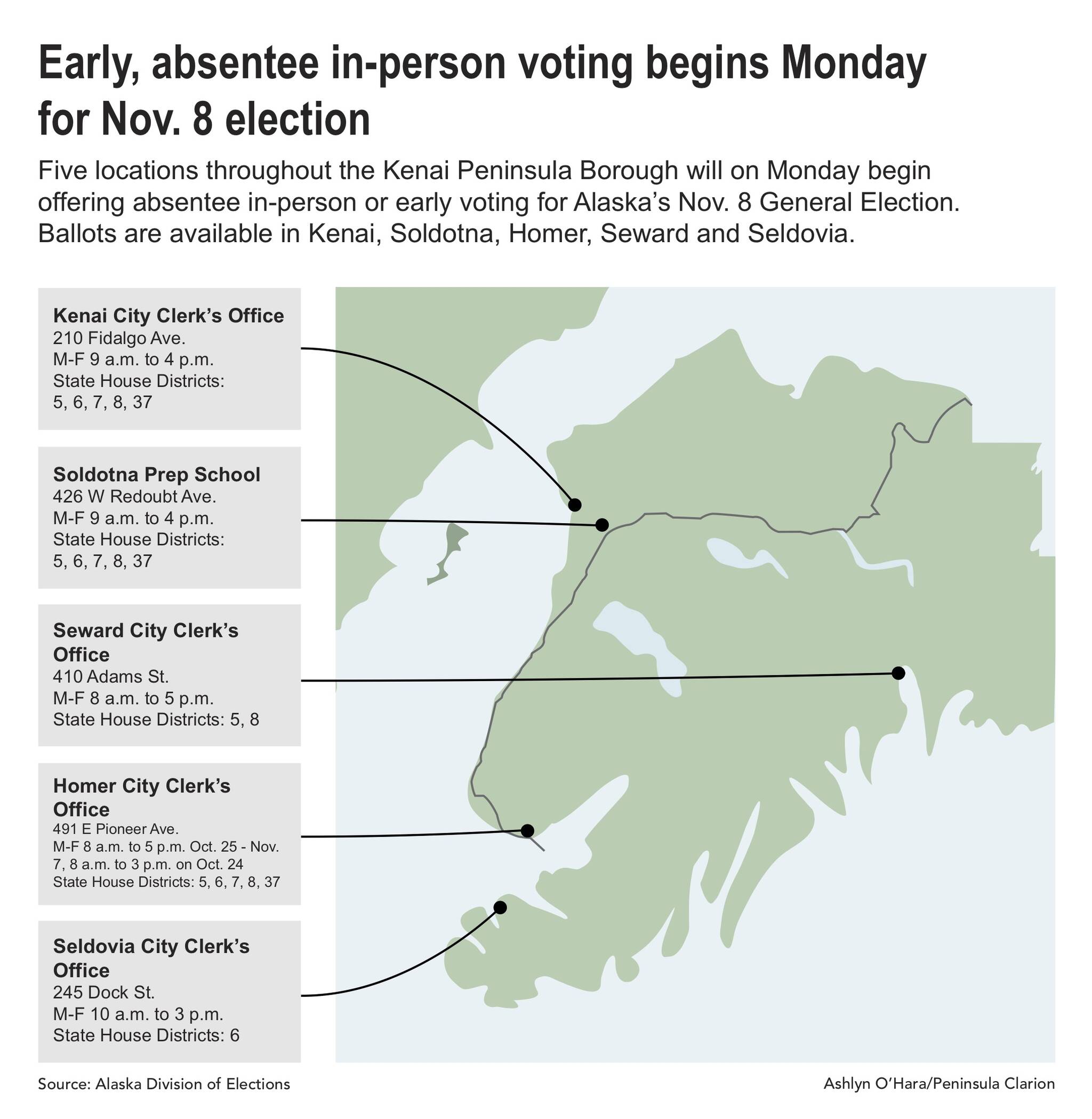Early and absentee in-person voting for Alaska’s Nov. 8 general election begins Monday.
Voters across Alaska will cast ballots in races for governor and lieutenant governor, U.S. senator and representative and Alaska State senators and representatives. Voters will also answer the once-in-a-decade question of whether or not the state should hold a constitutional convention.
Candidates vying for Alaska’s open U.S. Senate seat include incumbent Sen. Lisa Murkowski and challenger Kelly Tshibaka, both Republicans. Also on the ballot are Republican Buzz Kelley — who suspended his campaign in September — and Democrat Pat Chesbro.
Democratic U.S. Rep. Mary Peltola is running for reelection to the U.S. House of Representatives against former Alaska Gov. Sarah Palin and Nick Begich III, both Republicans, and Libertarian Chris Bye. Peltola was elected during a special election earlier this year to serve the remainder of the late Rep. Don Young’s term in the U.S. House.
Alaskans will also be asked on the Nov. 8 general election ballot whether a state constitutional convention should be held. The question is put before Alaska voters every 10 years, as required by the state’s founding document.
Those who oppose the measure say a constitutional convention would open the document to outside influence and potentially threaten Alaskans’ existing freedoms, while those in favor say a convention would provide an opportunity to address some of the state’s biggest concerns, such as Alaska Permanent Fund dividend payments.
If Alaskans vote in favor of calling a constitutional convention, any proposed changes to the document would also need to be approved by voters. Convention supporters say that process is one of the safeguards against unwanted amendments.
New districts
The names and exact boundaries of the Kenai Peninsula Borough’s state legislative districts have changed since last year. That’s because of redistricting, a process that happens once every 10 years after the U.S. census is collected.
Former State Senate District O is now State Senate District D. District D includes the Kenai/Soldotna area and covers the northern half of the Kenai Peninsula with borders extended to above Tustumena Lake. That district is currently represented by Peter Micciche, who has said he will not run for reelection. Tuckerman Babcock, Jesse Bjorkman and Andy Cizek are running for the seat.
Former State House District 30 is now State House District 7 and includes most of Kenai, Soldotna and Kalifornsky. That seat is currently held by Ron Gillham, who is running for reelection against Soldotna City Council member Justin Ruffridge.
Former State House District 29 is now State House District 8 and includes the Kenai Peninsula north of Tustumena Lake and east of Kasilof. It includes Bear Creek, but not Seward, which is in State House District 5 and State Senate District C. That district is currently represented by Ben Carpenter, who is running unopposed for reelection.
Voting before Election Day
Soldotna Prep School, located at 426 W Redoubt Ave. in Soldotna, offers early voting and is open from 9 a.m. to 4 p.m. Monday through Friday. That location has ballots for State House districts 5, 6, 7, 8 and 37.
The Homer City Clerk’s Office, located at 491 E Pioneer Ave. in Homer, offers early voting and is open from 8 a.m. to 5 p.m. Monday through Friday. Voting will be available from 8 a.m. to 3 p.m. on Monday, Oct. 24. That location has ballots for State House districts 5, 6, 7, 8 and 37.
Absentee in-person voting is available at the Kenai City Clerk’s office at 210 Fidalgo Avenue from 9 a.m. to 4 p.m. Monday through Friday. That location has ballots for State House districts 5, 6, 7, 8 and 37.
Absentee in-person voting is also available at the Seward City Clerk’s office at 410 Adams Street from 8 a.m. to 5 p.m. Monday through Friday. That location has ballots for State House districts 5 and 8.
Absentee in-person voting is also available at the Seldovia City Clerk’s office at 245 Dock Street from 10 a.m. to 3 p.m. Monday through Friday. That location has ballots for State House District 6.
Ranked choice voting
Voters will rank candidates for state office as part of the Nov. 8 election.
The ranked choice ballot shows a grid of bubbles, with one row for each candidate and one column for preference order. Voters fill in the bubble in the “1st Choice” column that corresponds to their first-choice candidate. Voters then move to the second column and fill in the bubble that corresponds to their second-choice candidate, and so on. Voters can rank up to four candidates, or just rank one, two or three candidates.
If a candidate receives more than 50% of the first-choice votes, that candidate would be declared the winner of the election.
If no candidate receives more than 50% of the first-choice votes, the candidate who received the least number of first-choice votes is eliminated. Then, the voters who ranked the eliminated candidate as their first choice would have their second-choice candidate votes distributed to the remaining candidates. The process will continue until one candidate emerges with more than 50% of the votes.
More information about this year’s state elections, as well as sample ballots by state legislative district, can be found on the Alaska Division of Elections website at elections.alaska.gov.
Reach reporter Ashlyn O’Hara at ashlyn.ohara@peninsulaclarion.com.

